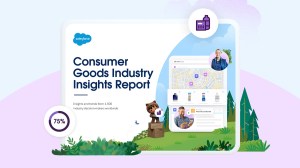Salesforce’s new Consumer Goods Industry Insights Report finds that data, deep personalization, and direct-to-consumer (DTC) models are becoming even more critical in a rapidly-evolving consumer landscape.
- The vast majority (93%) of consumer goods industry decision makers are using data to optimize prices and promotions, and 92% are using it for profitable growth.
- DTC channels account for more than 10% of overall revenue for nearly all (99%) CPG companies that have them, but respondents see an even bigger opportunity in the data and personalization opportunities these models bring.
The report, which is based on insights from 1,500 decision makers across the globe, reveals how overall outlooks, business strategies, and technology stacks are adjusting to digital transformation.
“As the consumer goods industry strives for profitable growth, leaders are leaning into data for increased visibility and better insights,” said Kishan Chetan, SVP & GM, Retail & Consumer Goods, Salesforce. “This first-party, proprietary data will become increasingly important in the very near future as generative AI becomes standard across customer relationship management platforms. The combination of AI, data, and CRM will allow every brand to connect with their customers in a whole new way.”
The combination of AI, data, and CRM will allow every brand to connect with their customers in a whole new way.
Kishan Chetan, SVP & GM, Retail & Consumer Goods, Salesforce
Here’s a sampling of key findings from the full report.
Spending outlook remains positive despite macroeconomic challenges
Despite a steady stream of mixed, if not outright gloomy, economic indicators for well over a year, consumer spending has remained steady or even grown slightly, and prices remain elevated. As a result, 90% of consumer goods industry decision makers expect profitable growth at their companies over the coming two years. What’s more, 77% expect to increase their marketing spend, with social media to see the largest boost.
Marketing spend can boost top-line growth and stave off the competition, an increasing concern for the industry. While supply chain difficulties still top the list of the industry’s woes, increased competition is now a close second on the list of overall challenges.
Amid challenges, there are also opportunities for consumer goods companies. Decision makers list product innovation at the top of their list of opportunities ahead, followed by DTC selling models.
The consumer goods industry is proactive in its approach to data management
The common thread in factors transforming the consumer goods industry — like other industries — is data. The increasing volume of data, along with the ability to use AI to take informed and timely action, provides immense opportunity to drive efficiencies, deepen customer relationships, and pursue new business opportunities and revenue streams.
Case in point: A recent survey of marketers found those in the consumer goods industry using an average of 18 data sources to inform customer engagement — up from the 10 they reported just two years previously.
A recent survey of marketers found those in the consumer goods industry using an average of 18 data sources to inform customer engagement — up from the 10 they reported just two years previously.
Consumer goods companies have taken this increasing reliance on data, and the need to make the most of it, to heart by making requisite investments. Nearly all (93%) respondents agree or strongly agree they can effectively use data to optimize prices and promotions, for example, and 92% say the same for their ability to use data to improve overall profitability.
Direct-to-consumer models are popular — and not just for increased revenue
DTC selling models are nothing new, but they are increasingly popular. In fact, a separate survey in 2022 found that 64% of consumers buy directly from a brand — up sharply from 49% in 2019.
In response, 91% of consumer goods decision makers say they now have some form of DTC structure in place. The revenue impacts are substantial: DTC channels account for more than 10% of overall revenue for nearly all (99%) companies that have them.
Yet despite its boon to the top line, consumer goods decision makers overall don’t rank incremental revenue as their top reason for selling DTC. Instead, two of the top value propositions for DTC revolve around the wealth of customer data they provide companies — such as insights on behaviors that can inform product innovation strategies or enable deep personalization that builds valuable relationships — and the third is around improved brand governance.
DTC selling still has its challenges, though, such as persuading customers to cut out retailer middlemen or shouldering marketing and customer service costs that retailers would otherwise take on.
Retail execution and trade promotion have room for improvement
Despite their embrace of DTC selling and direct customer relationships, tried-and-true sales through retailers and wholesalers still drive the bulk of consumer goods companies’ revenue streams. But an evolving retail landscape is proving difficult to navigate, and a significant portion of in-store product and marketing initiatives — nearly 40% on average — do not go as intended.
Survey respondents indicated particular dissatisfaction with the validity of out-of-stock statuses and their ability to act on analytics such as product assortment or promotional data. These challenges are likely compounded by the fact that only 36% of consumer goods decision makers report a high adoption of trade promotion software at their companies, thus relying in no small part on antiquated tools like spreadsheets to monitor and take action on retail logistics.
Consumer goods companies borrow from the retail playbook by embracing loyalty programs
Eighty-three percent of consumer goods decision makers believe it’s now harder than ever to maintain customer loyalty, with price sensitivity leading the list of hurdles to overcome in an inflationary environment.
Loyalty programs have been a mainstay for retailers for decades, and for good reason: 56% of consumers say they’re more likely to buy from brands with loyalty programs. As DTC becomes increasingly table stakes for consumer goods companies, so too are industry loyalty programs that help build deeper, more direct customer relationships. In fact, 70% of consumer goods decision makers now claim their companies have loyalty programs.
More information:
- Read the full Consumer Goods Industry Insights Report
- Learn more about Salesforce Consumer Goods Cloud
Methodology
Unless cited otherwise, data is from a double-anonymous survey of 1,500 consumer goods industry decision makers in Australia and New Zealand, Canada, France, Japan, Germany, the United Kingdom and Ireland, and the United States. The survey was live from February 16 through March 9, 2023. All respondents are third-party panelists. Additional information can be found in the report.















